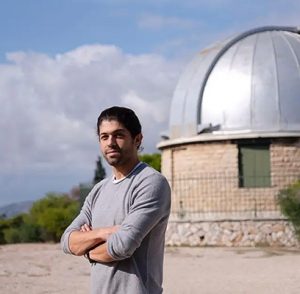A. Stargazing. Constellations and their Mythology
External talk about the Constellations and their Mythology. Who is the nymph Callisto and how do I find Polaris? Where did Perseus meet Andromeda? Why are Scorpio and Orion never together in heaven? We will navigate the Uranus (Uranography) using an astronomical laser and observe planets and stars with a portable telescope.
The action will take place in collaboration with the Department of Physics of the National and Kapodistrian University of Athens (NKUA).
For every age
B. Solar Observation
Solar observation using special equipment. We will safely observe the Sun and talk about its formations and action.
The action will take place in collaboration with the Department of Physics of the National and Kapodistrian University of Athens (NKUA).
For every age
C. Water rockets!
Children’s outdoor play. How do rockets go as far as space and what does Newton and his law have to do with it? A plastic bottle, a pump and some water are enough to find out the answer.
For children aged 5-15 years
D. James Webb Space Telescope. Humanity’s new eyes on space!
Let’s find out about James Webb, the largest space telescope ever built. How will it change what we know about the universe by observing it a few hundred million years after the Big Bang?
The presentation will be part of the action: Stand up Science kids/Science Reactors
For students and adults…





PROFESSIONAL EXPERIENCE
Obtained his BSc degree in Physics from the National and Kapodistrian University of Athens. He also holds a MSc degree in Astronomy and Space Physics, awarded by the University of Uppsala in Sweden. His MSc thesis was focused on the behavior of the Saturnian Magnetosphere under different Solar Wind conditions. He has also studied drama at the Piraeus drama school.
RESEARCH INTERESTS
His main research interests are the physics of the planetary magnetospheres and the origin of the planetary systems. Actively enrolled into various aspects of science communication, public engagement and outreach activities. In 2012 he was awarded the first prize in the FameLab Science Communication competition and represented Greece at the International Final at Cheltenham International Science Festival. As of 2014 he has been supporting the public outreach and science communication program of the Visitor Centers of the National Observatory of Athens, regularly operating the Doridis historical telescope located on the hill of Pnyx.
The first Research Center in Greece and Southeastern Europe
The National Observatory of Athens is a research center operating under public law rules and procedures and is supervised by the General Secretariat for Research and Technology of the Ministry of Development and Investment\
The Center was established in 1842 offering since then its services to research, science, and society. The National Observatory of Athens with its highly-skilled human resources and important infrastructure plays today an important role in research in the fields of Astronomy, Astrophysics, Space applications, Environment, Energy and Meteorology, Seismology, and Geodynamics, at European and international level.
The Visitor Center in Thissio is located on the Hill of the Nymphs and it is housed in the Sina building (photo on the right). The construction of the building commenced in 1842 after the generous donation of George Sinas, a businessman and ambassador of Greece in Vienna, and led to the establishment of the Observatory of Athens. The building itself was designed by the Danish architect Theophil Hansen. The site is situated across from the Parthenon and just to the north of the hill of Pnyx, where Meton built his heliotrope in the 5th century BC to perform the first astronomical observations of the classical Greek period.
The goal of the Center is twofold: to inform the general public on a wide number of Astronomy related topics and at the same time to present the nearly two century long history of Greek Astronomy and NOA, a history which has been shaped by the major transitional periods in the evolution of the modern Greek state.
The visitors of the Center will have the opportunity to explore the Geoastrophysics Museum, the library of the Observatory, which contains many historic books and documents, as well as a variety of scientific instruments of the 20th and 19th century. They can also examine from close by the first optical telescopes of Greece, including the meridian refractor of G. Bouris (1846) and the original 16cm telescope housed under the dome of the Sina’s building. The latter was used by Julius Schmidt, the third Director of the NOA (1858-1884), in order to draw the most accurate map of the Moon during that period.







